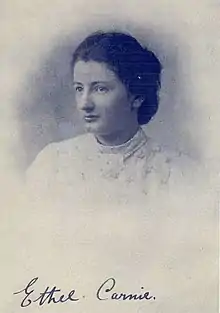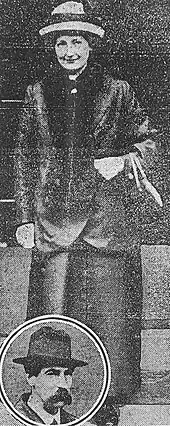Ethel Carnie Holdsworth
Ethel Carnie Holdsworth (1 January 1886 – December 1962), working-class writer, feminist, and socialist activist from Lancashire[1] (also published as Ethel Carnie and Ethel Holdsworth). Poet, journalist, children's writer and author, Carnie Holdsworth was the first working-class woman in Britain to publish a novel and is a rare example of a female working-class novelist.[2] She published at least ten novels during her lifetime.
Ethel Carnie Holdsworth | |
|---|---|
 Ethel Carnie Holdsworth in 1907 | |
| Born | Ethel Carnie 1 January 1886 near Blackburn, Lancashire, England |
| Occupation | Mill girl, Socialist campaigner, Novelist |
| Notable works | Rhymes From the Factory (1907), Helen of Four Gates (1917), This Slavery (1925) |
| Spouse | Alfred Holdsworth |
Childhood
The British writer Ethel Carnie Holdsworth was born on 1 January 1886 into a weaving family in Oswaldtwistle, Lancashire. When she was six her parents moved to the growing textile town of Great Harwood, near Blackburn. She started part-time work at Delph Road mill in Great Harwood at aged eleven and was in full-time employment at St. Lawrence mill from thirteen. In her later articles for the Woman Worker, she described her experience as "slavery".
Education
Holdsworth attended Great Harwood British School from 1892. According to Edmund and Ruth Frow, she showed promise in composition and often had her essays read out to the rest of the class, but otherwise showed no outstanding ability.[3] She studied at Owens College (University of Manchester) during the 1911/12 academic session and matriculated on 11 January 1912.
Early writing
Holdsworth started composing poetry while working as a winder at the St. Lawrence mill. Her first book of poems, Rhymes from the Factory, was published in 1907. When this was republished in an enlarged one shilling edition in 1908 she achieved national recognition.[4] Robert Blatchford, proprietor of the Clarion, interviewed Ethel Carnie at 76 Windsor Road, Great Harwood, in the summer of 1908 for a feature in one of his newspapers, the Woman Worker. Carnie Holdsworth appeared in the newspaper's 'Portrait Gallery' under the title 'A Lancashire Fairy'.[5] Blatchford offered her a job writing articles and poems for the Woman Worker, in London, which she also edited between July and December 1909. Carnie was dismissed after six months for reasons which remain obscure. Edmund and Ruth Frow suggest that her increasingly political and feminist editorials may have caused Blatchford to reassess her input.[6]
A second book of poems, Songs of a Factory Girl, was published in 1911, and her third and final collection of poems, Voices of Womanhood, followed three years later. Holdsworth taught creative writing at Bebel House Women's College and Socialist Education Centre in London in 1913, but returned to Great Harwood before the end of the year. Her first novel, Miss Nobody, was published in the same year.
Political activities
Holdsworth protested against the introduction of conscription in World War I and chaired local meetings of the British Citizen Party.[7] During the 1920s she edited and produced The Clear Light, an anti-fascist journal, with her husband Alfred Holdsworth from their home in Slack Top, Hebden Bridge. In this period she also published a series of sonnets in the anarchist journal Freedom, protesting at the imprisonment of anarchists in Soviet jails.
Literary significance
Dr Kathleen Bell is one of the leading figures in the campaign to introduce the work of this long-forgotten writer to a new generation. She writes that
"at its best, Holdsworth's poetry illuminates the gap between working-class people's desire for liberty, often evident in their imaginative capacity, and the constraints and suffering of their lives".
The children's story "The Blind Prince" (in The Lamp Girl and other stories, 1913) shows the influence of Oscar Wilde. This Slavery (1925) is Holdsworth's best-known work. Holdsworth wrote poems and short stories until 1936 but there is no record of her writing after this date. Holdsworth's daughter Margaret told an interviewer that her mother stopped writing because she was worn out and depressed about the imminent outbreak of World War II. This Slavery was republished by Trent Editions in November 2011, with a critical introduction by Dr Nicola Wilson.
Since 2013, independent publisher Kennedy & Boyd have been bringing Ethel Carnie Holdsworth's writing back into the public domain, with republications of Miss Nobody (1913; 2013), Helen of Four Gates (1917; 2016) and General Belinda (1924; 2019).
Personal life

Carnie married the poet Alfred Holdsworth in 1915. They had two daughters. She later separated from her husband. From the early 1930s onwards she lived in Cheetham Hill, Manchester.[8]
Miscellaneous
The composer Ethel Smyth set two of Holdsworth's poems in the song cycle Three Songs (1913). Smyth dedicated "Possession" to Emmeline Pankhurst and "On the Road: a marching tune" to Christabel Pankhurst. The latter song was premiered in 1913 at the Queen's Hall, London.[9]
The novel Helen of Four Gates (1917) was filmed in 1920. Prints exist in the Cinémathèque Québécoise film archive [35mm positive], and in the International Museum of Photography and Film at George Eastman House film archive [16mm reduction positive]. It is available online at http://player.bfi.org.uk/film/watch-helen-of-four-gates-1920/ Holdsworth is buried at Blackley Cemetery, Manchester, in the non-conformists' section - Grave A 183.
Works
- Rhymes from the Factory (Blackburn: Denham, 1907)
- Songs of a Factory Girl (London: Headley Brothers, 1911)
- The Lamp Girl, and other stories (London: Headley Brothers, 1913)
- Miss Nobody (London: Methuen, 1913) (Reprinted with new Introduction: Kennedy & Boyd, 2013)
- Voices of Womanhood (London: Headley Brothers, 1914)
- Helen of Four Gates (London: Herbert Jenkins, 1917) (Reprinted with new Introduction: Kennedy & Boyd, 2016)
- The Taming of Nan (London: Herbert Jenkins, 1919)
- The Marriage of Elizabeth (London: Herbert Jenkins, 1920)
- The House that Jill Built (London: Herbert Jenkins, 1920)
- General Belinda (London: Herbert Jenkins, 1924) (Reprinted with new Introduction: Kennedy & Boyd, 2019)
- This Slavery (London: Labour Publishing Company, 1925)
- The Quest of the Golden Garter (London: Herbert Jenkins, 1927)
- Eagles' Crag (London: Stanley Paul, 1928)
- Barbara Dennison (London: Stanley Paul, 1929)
References
- https://www.theguardian.com/books/booksblog/2012/mar/08/neglected-women-writers-class-issue
- The Socialist Novel In Britain, ed. by H. Gustav Klaus (Brighton: Harvester, 1982) 0-7108-0340-0
- Edmund and Ruth Frow, 'Ethel Carnie Holdsworth: Writer, Feminist and Socialist', in The Rise of Socialist Fiction 1880-1940, ed. by H. Gustav Klaus (Brighton: Harvester, 1987), 251-56
- Keighley Snowden, 'A Book of the Hour. Factory Lass and Poetess', Woman Worker, 3 July 1908, 135.
- Robert Blatchford, 'A Lancashire Fairy, An Interview with Miss Ethel Carnie', Woman Worker, 10 July 1908, 155.
- Edmund and Ruth Frow, 'Ethel Carnie Holdsworth: Writer, Feminist and Socialist', in The Rise of Socialist Fiction 1880-1940, ed. by H. Gustav Klaus (Brighton: Harvester, 1987), 251-56
- Roger Smalley, 'The Life and Work of Ethel Carnie Holdsworth, with particular reference to the period 1907 to 1931' (unpublished doctoral thesis, University of Central Lancashire, 2006)
- Wilson, Nicola. "Another perspective of Ethel Carnie". Cottontown Blackburn with Darwen. Retrieved 21 July 2016.
- Bennett, Jory (1987). Crichton, Ronald (ed.). The Memoirs of Ethel Smyth: Abridged and Introduced by Ronald Crichton, with a list of works by Jory Bennett. Harmondsworth: Viking. pp. 378–379. ISBN 0-670-80655-2.